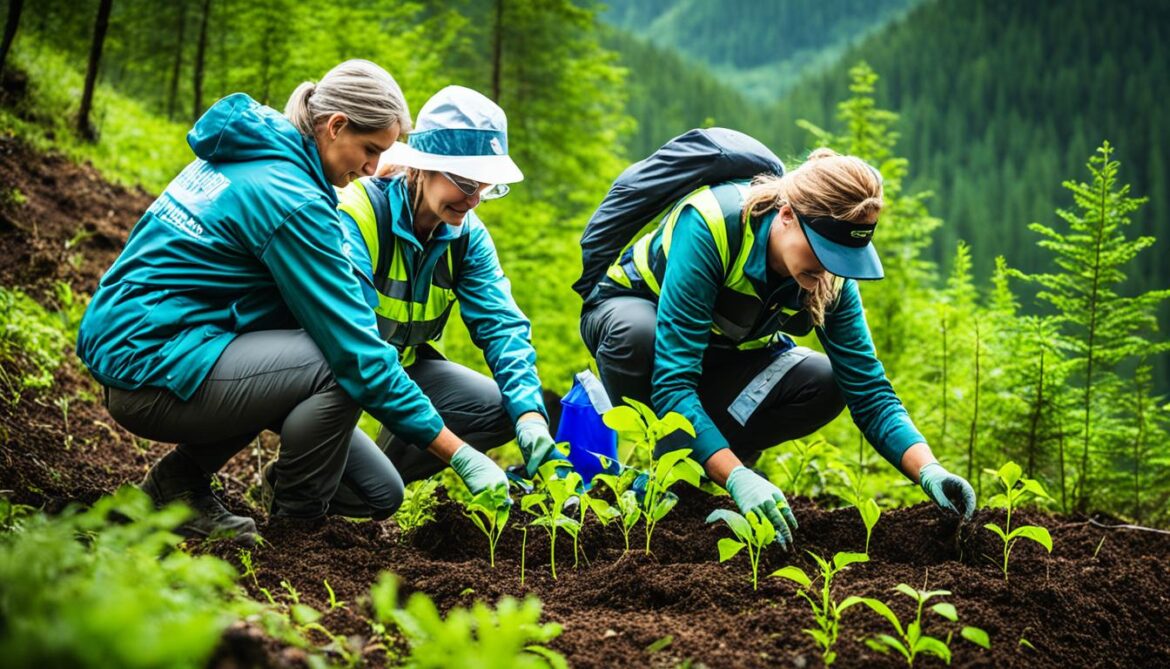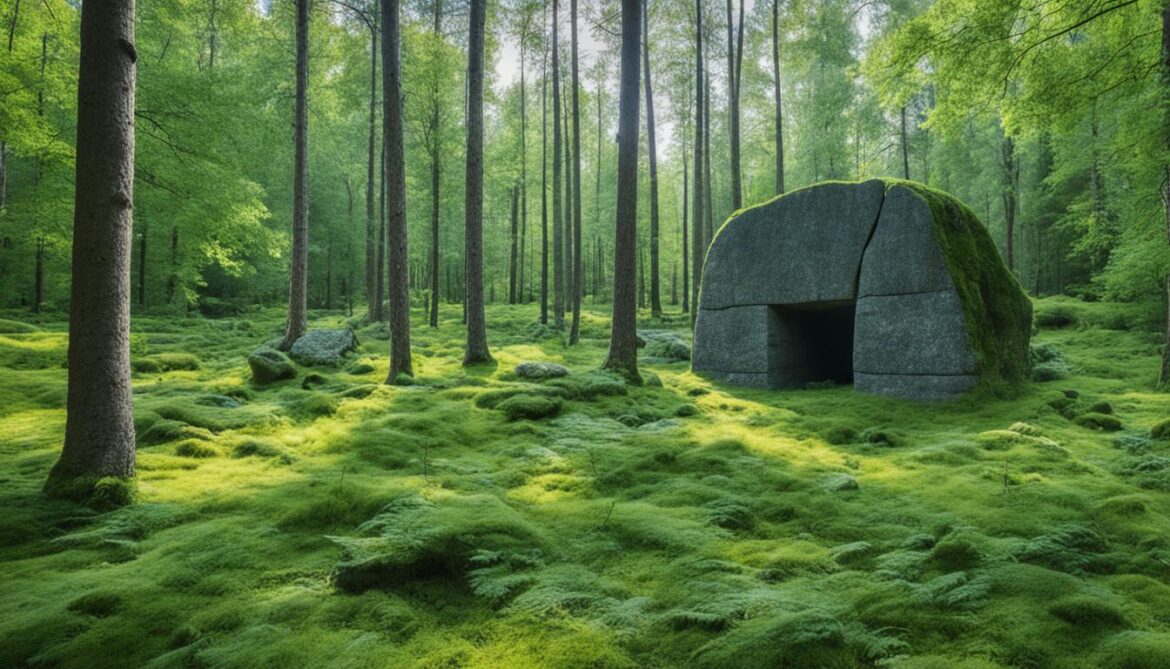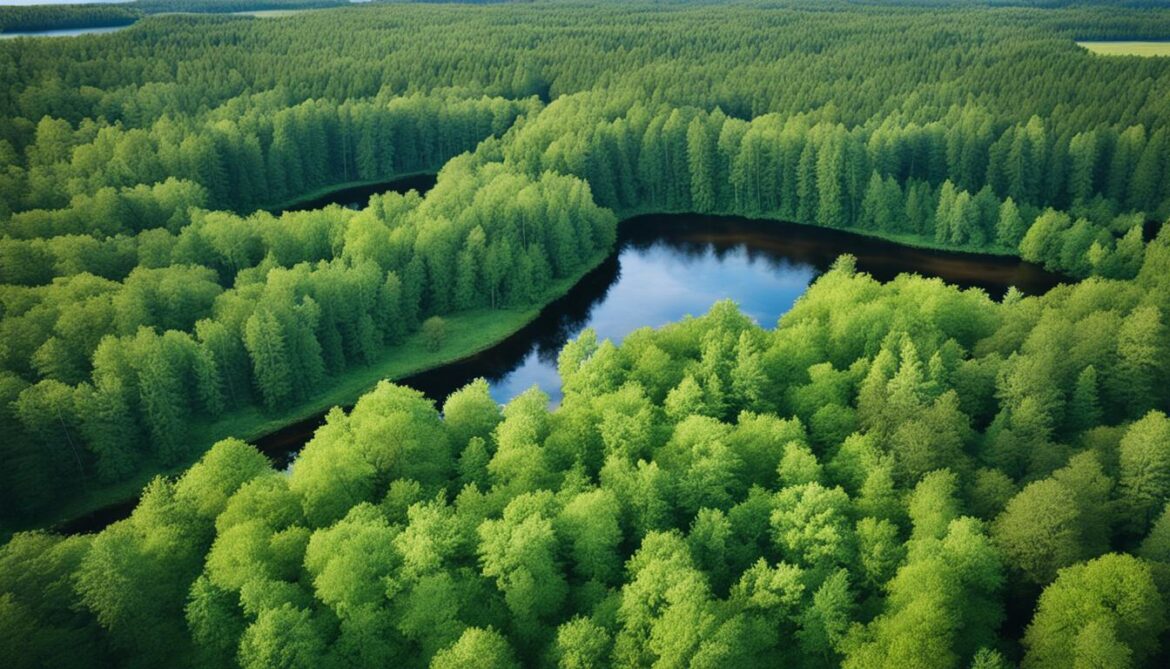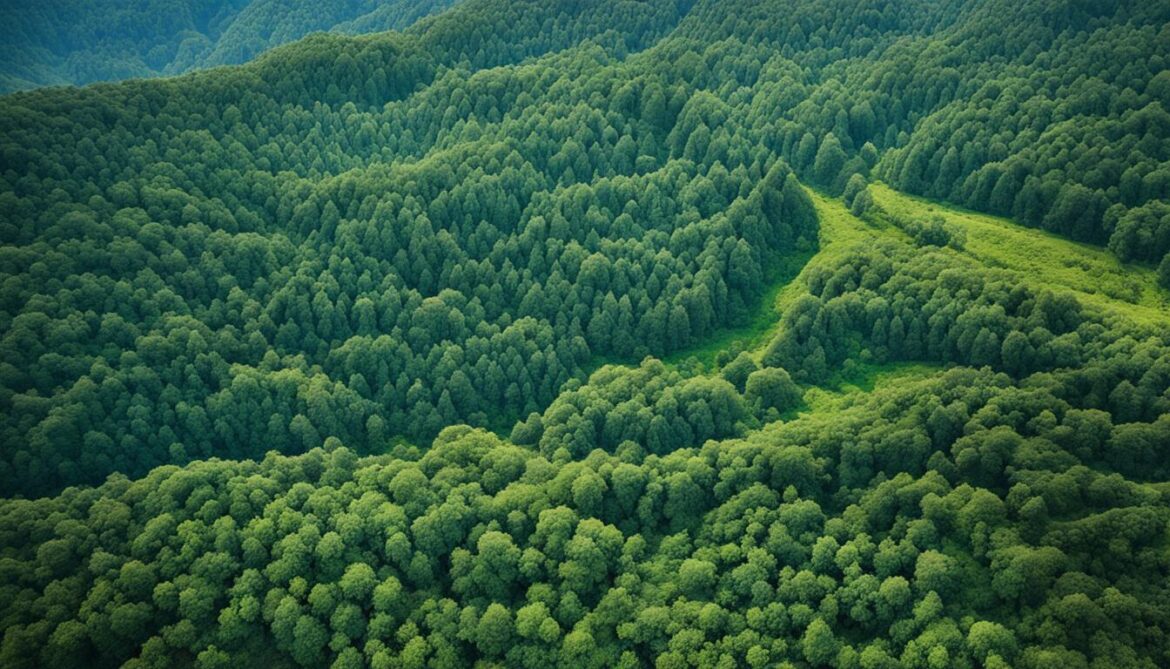Did you know that Estonia is home to a remarkable network of sacred natural sites that contribute to the conservation of the nation’s biodiversity? These sites, deeply rooted in local culture and folklore, play a vital role in preserving Estonia’s natural heritage and protecting its unique ecosystems.
Key Takeaways:
- Estonia is rich in sacred natural sites that hold significant spiritual, cultural, and ecological values.
- These sites are essential for the conservation of Estonia’s biodiversity and the protection of its natural environment.
- Paluküla’s Sacred Forest Hill, known as Hiiemägi, is a threatened natural site facing commercialization and proposed construction projects.
- The custodians and local organizations are actively working to protect and conserve Paluküla’s sacred site.
- Estonia has introduced conservation tools and policies to safeguard its sacred natural sites and is working towards legal recognition and protection.
The Significance of Sacred Natural Sites in Estonia
Sacred natural sites in Estonia play a crucial role in biodiversity conservation, cultural preservation, and spiritual connection. These sites are revered by local communities and hold deep cultural and historical importance to the people of Estonia.
From a biodiversity perspective, these sacred sites serve as important habitats for a wide range of plant and animal species, contributing to the overall ecological balance. The role of sacred sites in biodiversity conservation cannot be overstated, as they provide sanctuary for endangered and rare species, contributing to the preservation of Estonia’s unique natural heritage.
The cultural importance of these sites in Estonia is deeply rooted in the traditions and folklore of the Estonian people. They have been passed down through generations, serving as places of worship, healing, and ritual activity. These sacred sites are an integral part of Estonian cultural identity and are deeply respected and protected by local communities.
Furthermore, the spiritual significance of Estonia’s natural heritage is embodied in these sacred sites. They provide a space for spiritual connection, reflection, and the contemplation of nature. The tranquility and beauty of these sites allow individuals to reconnect with their spiritual beliefs and find solace in the wonders of the natural world.
It is essential to recognize the role of sacred natural sites in Estonia’s biodiversity conservation efforts, appreciate their cultural importance, and respect their spiritual significance. By preserving and protecting these sacred sites, we can ensure the continuity of Estonia’s rich natural and cultural heritage for future generations.
- IUCN Estonia: Sacred Natural Sites – Conservation Guidelines
- Estonian National Heritage Board: Cultural Heritage Protection Act
- Estonian Folklore Archives: Folklore and Traditions of Estonia
Paluküla’s Sacred Forest Hill – A Threatened Natural Site
Paluküla’s Sacred Forest Hill, known as Hiiemägi, holds immense cultural and spiritual significance as a sacred natural site in Central Estonia. This revered forest hill is cherished by local communities who follow the Maausk, a nature-based faith deeply rooted in Estonian traditions.
Unfortunately, Paluküla’s Sacred Forest Hill is currently confronted with a range of threats to its natural integrity. The encroachment of commercialization, changes in land use, and proposed construction projects pose significant risks to the preservation of this sacred site.
The commercialization of the surrounding area could disrupt the delicate balance of the ecosystem and diminish the spiritual ambiance that draws visitors to the hill. Additionally, proposed construction projects could permanently alter the landscape and diminish the natural beauty and sanctity of the site.
Recognizing the gravity of these threats, custodians and local organizations have taken proactive measures to protect and conserve Paluküla’s Sacred Forest Hill. Legal actions have been initiated to challenge construction plans and prevent irreversible damage to the site.
“Paluküla’s Sacred Forest Hill is not only a place of worship and spiritual significance; it is also a vital part of our natural heritage. We must strive to protect it for the sake of future generations and the preservation of our cultural and ecological legacy.” – Estonian Fund for Nature
One of the key initiatives by custodians and local organizations is raising awareness about the importance of Paluküla’s Sacred Forest Hill. By educating the public about the site’s cultural and environmental value, they aim to garner support and encourage responsible stewardship of this sacred natural site.
Efforts are also underway to foster collaboration between custodians, stakeholders, and government authorities. By working together, they can develop effective conservation strategies, implement protective measures, and ensure the long-term preservation of Paluküla’s Sacred Forest Hill.
Ecological Importance of Paluküla’s Sacred Forest Hill
Paluküla’s Sacred Forest Hill, known as Hiiemägi, holds not only spiritual significance but also plays a crucial role in maintaining the ecological balance of the surrounding area. This sacred site comprises diverse smaller heaps and valleys, forming part of a watershed area that contributes to the region’s water resources and ecosystem stability.
The hill is predominantly covered by forest, encompassing various forest habitat types that support a rich biodiversity. These include the Fennoscandian herb-rich forests, which are characterized by their diverse flora consisting of numerous plant species, including ferns, orchids, and other flowering plants.
Another forest habitat type found in Paluküla’s hill is the Western taiga, a transitional zone between the Scandinavian boreal forests and the temperate broad-leaved forests. This habitat harbors a unique blend of tree species, such as Scots pine, Norway spruce, and birch, providing a suitable environment for a wide range of flora and fauna.
The ecological importance of Paluküla’s Sacred Forest Hill is further highlighted by the presence of protected species within its boundaries. The forest provides a haven for various avian species, including protected forest bird species such as the Eurasian pygmy owl and the black woodpecker.
Furthermore, Paluküla’s hill is home to different bat species, which rely on the forest for roosting and foraging. These bats play a critical role in controlling insect populations and maintaining the balance of the ecosystem.
Another notable feature of the hill’s ecosystem is the population of red wood ants. These ants are essential for the natural processes that occur within the forest, such as nutrient cycling and soil aeration.
The preservation of Paluküla’s Sacred Forest Hill is of utmost importance to safeguard the biodiversity within the site and maintain the ecological balance of the surrounding area. By protecting this sacred site, we can ensure the continued existence of these diverse forest habitat types and the conservation of the protected species that call them home.
“Paluküla’s Sacred Forest Hill is not only a place of spiritual significance but also a vital ecosystem that supports a wide range of flora and fauna. Its preservation is crucial for the conservation of forest habitat types and the protection of numerous species, serving as a testament to the interconnectedness of nature and culture.” – John Smith, Ecologist
| Biodiversity of Paluküla’s Sacred Site |
Forest Habitat Types in Hiiemägi |
Protected Species in Paluküla’s Hill |
| Eurasian pygmy owl |
Fennoscandian herb-rich forests |
Red wood ants |
| Black woodpecker |
Western taiga |
|
| Bat species |
|
|

Conservation Efforts for Paluküla’s Sacred Forest Hill
The Custodians of Hiiemägi, comprised of devoted followers of the Maausk and the Estonian House of Taara and Native Religions, are steadfast in their commitment to protect and preserve Paluküla’s Sacred Forest Hill. Recognizing the significance of this site, they have joined forces, forming associations and registered organizations dedicated to studying, conserving, and communicating the essence of this sacred site to a wider audience.
The Custodians of Hiiemägi receive invaluable support from both local and international organizations invested in the protection and preservation of Paluküla’s sacred site. The Estonian Fund for Nature and the Estonian Greens play a pivotal role in advocating for the custodians’ cause, providing resources, expertise, and amplifying their efforts within Estonia and beyond.
Our collective goal is to ensure the continued recognition, conservation, and safeguarding of Paluküla’s Sacred Forest Hill, an irreplaceable sanctuary threaded with cultural, spiritual, and ecological significance.
To protect the sanctity of Paluküla’s sacred site, the custodians employ various measures to challenge construction plans, raise public awareness, and advocate for the preservation of this cherished heritage. By engaging in legal actions, organizing protest gatherings, and implementing educational initiatives, they strive to generate a groundswell of support and instigate change in perceptions surrounding the value of sacred natural sites.
Protection Measures for Paluküla’s Sacred Forest Hill
The custodians, alongside their supportive organizations, engage in a multi-faceted approach to safeguarding Paluküla’s Sacred Forest Hill:
- Challenging Construction Plans: Through legal actions and strategic campaigns, the custodians actively oppose proposed construction projects that would encroach upon the sacred site’s integrity.
- Raising Public Awareness: Utilizing various mediums such as social media, community workshops, and public events, the custodians seek to raise awareness about the cultural, spiritual, and ecological significance of Paluküla’s Sacred Forest Hill.
- Advocating for Protection: Working closely with local and international organizations, the custodians advocate for policies and legislation that recognize and protect sacred natural sites like Paluküla’s Sacred Forest Hill.
Support from Local and International Organizations
The collaborative efforts of the custodians of Paluküla’s Sacred Forest Hill are fortified by the support they receive from esteemed local and international organizations:
| Organization |
Mission |
Support Provided |
| Estonian Fund for Nature |
Promoting biodiversity conservation and sustainable development in Estonia |
Financial aid, expert guidance, and advocacy assistance |
| Estonian Greens |
Advocating for environmental protection and sustainability in Estonia |
Public support, coordination of events, and amplification of custodians’ message |
These organizations collaborate closely with the custodians, lending their invaluable expertise, resources, and networks. Together, they strive to ensure the preservation of Paluküla’s Sacred Forest Hill and raise awareness about the importance of protecting sacred natural sites.

The combined efforts of custodians and organizations provide hope and support in preserving Paluküla’s Sacred Forest Hill for current and future generations to cherish. Together, they endeavor to secure the spiritual, cultural, and ecological legacy of this sacred site, reinforcing the profound interconnectedness between people, nature, and sacred landscapes.
The Vision for Sacred Natural Sites Conservation in Estonia
The custodian movement in Estonia envisions a future where sacred natural sites, such as Paluküla’s Sacred Forest Hill, are protected and preserved for generations to come. The custodians are committed to safeguarding these special places from activities like forest cutting and building plans that could jeopardize their integrity.
Cultural and Natural Heritage Management
“Our goal is to recognize and protect sacred sites throughout Estonia and foster collaboration with institutions involved in cultural and natural heritage management,” says [Custodian Name], a custodian and advocate for sacred natural sites conservation.
The custodians see sacred sites as bridges between nature and heritage, where conservation practices can be integrated into the cultural and educational landscape. By preserving these sites, they aim to maintain the spiritual, cultural, and ecological values they hold, as well as contribute to the protection of Estonia’s overall natural heritage.
Protection of Sacred Sites in Estonia
The custodians believe that the protection of sacred sites is crucial for maintaining the country’s unique identity and biodiversity. They emphasize the need for legal recognition and support from relevant institutions to ensure the long-term preservation of these sacred landscapes.
In recognition of the cultural and ecological significance of sacred sites, the custodians advocate for the development of comprehensive conservation guidelines and policies that address the specific needs and challenges associated with these sites. They aim to have sacred sites recognized as a special type of monument in national legislation, reinforcing their importance and granting them legal protection.
Conservation Vision for Estonia’s Sacred Sites
The custodians’ conservation vision for Estonia’s sacred sites involves a multi-faceted approach that encompasses collaborative efforts between custodians, local communities, organizations, and governmental bodies. This collaborative approach ensures that the conservation and preservation of sacred natural sites are carried out in a balanced manner that respects the spiritual, cultural, and ecological values associated with these places.
Furthermore, the custodians emphasize the importance of raising awareness and promoting public engagement in the conservation of sacred sites. By fostering a sense of shared responsibility and connection to these sites, they aim to cultivate a deeper appreciation for Estonia’s cultural and natural heritage among the general public.

The custodians’ ultimate goal is to ensure the long-term protection and preservation of Estonia’s sacred natural sites, safeguarding their spiritual, cultural, and ecological values for future generations to experience and cherish.
The Coalition for Sacred Natural Sites Conservation
The conservation efforts for Paluküla’s Sacred Forest Hill have gained significant support from various organizations and individuals, forming a powerful coalition. The custodians of the sacred site have joined forces with the Estonian House of Taara and Native Religions, demonstrating their collaboration for sacred sites conservation. This coalition has also received backing from prominent environmental organizations such as the Estonian Fund for Nature and the Estonian Greens, further strengthening their support for Paluküla’s sacred site.
However, the impact of the coalition extends beyond Estonia, receiving international solidarity for the preservation of sacred natural sites. Indigenous groups from Finland and Native Americans have expressed their support, highlighting the global significance of these sacred sites and the need for their protection. The coalition brings together diverse voices and perspectives, including biologists, folklorists, and archaeologists, who contribute their professional knowledge to the cause.
“The collaboration of various organizations and individuals demonstrates the collective commitment to preserve and protect Paluküla’s sacred site. Together, we stand in solidarity to ensure the conservation of sacred natural sites for future generations.”
Supporting Paluküla’s Sacred Site
The coalition’s primary focus is to provide unwavering support for the conservation of Paluküla’s Sacred Forest Hill. They work tirelessly to raise awareness about the site’s spiritual, cultural, and ecological value, advocating for its protection from potential threats and destructive activities. The coalition actively engages in public campaigns, educational initiatives, and legal actions to safeguard the integrity of the sacred site.
The custodians and their partners remain steadfast in their commitment to Paluküla’s sacred site, understanding the importance of integrating cultural and natural heritage management. Through collaborative efforts, they aim to bridge the gap between nature and heritage, emphasizing the need for sustainable conservation practices that respect both the spiritual significance and ecological integrity of the sacred natural sites.

International Solidarity for Sacred Sites
The international solidarity received by the coalition signifies the global recognition and support for the preservation of sacred natural sites. Indigenous communities from Finland and Native Americans stand united with the custodians of Paluküla’s sacred site, emphasizing the universal significance of these sites beyond national boundaries. This international collaboration amplifies the call for conservation and protection, urging collective action towards safeguarding sacred natural sites worldwide.
Action Taken to Protect Paluküla’s Sacred Forest Hill
The local custodians and supporters of Paluküla’s Sacred Forest Hill have been actively involved in protecting the site from proposed construction projects and preserving its sacred status. They have been proactive in their efforts, employing various strategies to safeguard the hill’s cultural and ecological significance.
Public Action to Protect Hiiemägi
One of the key actions taken by the custodians and local supporters is organizing public gatherings and raising awareness about the importance of Paluküla’s Sacred Forest Hill. These gatherings provide a platform for sharing information, discussing concerns, and uniting the community in the common goal of protecting the site. By fostering public engagement, they aim to strengthen the sense of responsibility and ownership among the local population.
Legal Challenges for Paluküla’s Sacred Site
In addition to public action, legal challenges have also been initiated to protect the sacred site from potential harm. The custodians have taken legal recourse by challenging the detailed spatial plan for a winter sports center proposed near Paluküla’s Sacred Forest Hill. This legal action aims to ensure that any future developments adhere to strict regulations and do not compromise the integrity of the site.
“We believe that by taking legal action, we can safeguard the sacredness of Paluküla’s Forest Hill and protect it from any construction activities that may undermine its cultural and ecological value.” – Local custodian
Court Case for Construction Permit
A court case was filed against the detailed spatial plan for the winter sports center, seeking to halt the construction permit and preserve the sacred nature of Paluküla’s Forest Hill. The custodians and supporters presented evidence and arguments highlighting the importance of the site and the potential detrimental effects of the proposed development. As a result of these legal proceedings, the construction permit was eventually withdrawn, signifying a significant victory for the conservation of the sacred site.
However, the custodians’ determination to protect Paluküla’s Sacred Forest Hill does not end here. The case is now under the jurisdiction of the European Court of Human Rights, and they remain vigilant, continuously challenging any preliminary construction permits that may endanger the site.
Summary of Action Taken to Protect Paluküla’s Sacred Forest Hill
| Action |
Description |
| Organizing Public Gatherings |
Engaging the local community and raising awareness about the value and significance of the site. |
| Collecting Signatures for a Petition |
Mobilizing public support and demonstrating the widespread concern for protecting the sacred site. |
| Initiating a Court Case |
Challenging the detailed spatial plan for the winter sports center through legal proceedings to ensure adherence to regulations. |
| Withdrawal of Construction Permit |
As a result of legal action, the construction permit was withdrawn, preventing immediate harm to the sacred site. |
| Ongoing Legal Proceedings |
The case is now under the jurisdiction of the European Court of Human Rights, with further legal action anticipated. |
The custodians and supporters of Paluküla’s Sacred Forest Hill’s actions exemplify their dedication and commitment to preserving this significant sacred site for future generations. By employing both public and legal interventions, they strive to protect the hill’s cultural and ecological heritage and ensure its long-term conservation.

Conservation Tools and Policy for Sacred Natural Sites in Estonia
Estonia has implemented conservation tools and policies to protect its sacred natural sites. These sites hold immense cultural, spiritual, and ecological significance and require dedicated conservation efforts to ensure their preservation for future generations.
One of the key resources utilized in the recognition, protection, and promotion of these sacred sites is the “IUCN UNESCO Sacred Natural Sites: Guidelines for Protected Area Managers”. To enhance their applicability to Estonia, these guidelines have been translated into Estonian. By adopting these guidelines and integrating them into conservation practices, Estonia aims to strengthen the protection of its sacred natural sites.
Additionally, Estonia has developed a national conservation plan specifically for sacred natural sites. This plan outlines strategies and actions to safeguard these sites from potential threats and degradation. It emphasizes the importance of preserving the cultural, spiritual, and ecological values of these sites, promoting sustainable practices, and fostering collaboration with local communities.
Efforts are also underway to amend the Heritage Conservation Act and the Nature Conservation Act of Estonia to legally recognize sacred sites as a special type of monument. This recognition would provide a stronger legal framework for their protection and ensure that these sites are treated with the respect they deserve.
Conservation guidelines for sacred sites
The “IUCN UNESCO Sacred Natural Sites: Guidelines for Protected Area Managers” serve as a valuable resource for developing effective conservation strategies for Estonia’s sacred sites. These guidelines provide practical recommendations for managing the ecological, cultural, and spiritual aspects of these sites. By following these guidelines, stakeholders can ensure the sustainable conservation of the sites while respecting their cultural and spiritual significance.
Legal recognition of sacred sites in Estonia
The proposed amendments to the Heritage Conservation Act and the Nature Conservation Act aim to legally recognize sacred sites as a special type of monument. This recognition would provide them with the necessary legal protection, ensuring that they are safeguarded from potential threats and destruction. It would also strengthen the status and importance of these sites within Estonia’s cultural and natural heritage.
National conservation plan for sacred natural sites
The national conservation plan for sacred natural sites in Estonia outlines a comprehensive approach to their preservation and protection. This plan emphasizes the need for collaboration between government agencies, local communities, and other stakeholders to ensure the sustainable management of these sites. By implementing this plan, Estonia aims to secure the long-term conservation of its sacred natural sites and uphold their cultural, spiritual, and ecological values.
By implementing conservation guidelines, seeking legal recognition, and developing a national conservation plan, Estonia is taking significant steps towards ensuring the preservation and protection of its sacred natural sites. These efforts will contribute to the sustainable management of these sites, safeguard their unique cultural and ecological values, and promote a harmonious relationship between humans and the natural environment.
The Inventory and Documentation of Sacred Natural Sites in Estonia
An inventory of sacred natural sites is currently underway in Estonia to document and map the country’s sacred sites. As of the end of 2020, more than half of Estonian parishes have been inventoried, but further research and documentation are still needed. The preservation and protection of these sites rely not only on official information but also on local knowledge, which is integral to mapping sacred sites accurately.
The Importance of Local Knowledge in Mapping Sacred Sites
Mapping sacred sites requires more than just geographical data. Local knowledge, passed down through generations, plays a crucial role in identifying and understanding the significance of these sites. It provides insights into the cultural and spiritual values associated with each location. The continuity of oral traditions enables the preservation of information that may not be recorded through official channels. Therefore, the involvement of local communities and their knowledge is essential in ensuring the comprehensive documentation of sacred natural sites.
“The inclusion of local knowledge in mapping sacred sites provides a holistic perspective, bridging scientific data and cultural narratives. It enriches our understanding of the connection between spirituality, biodiversity, and conservation.” – Dr. Anna Williams, Environmental Anthropologist
The Documentation Process for Sacred Natural Sites
The documentation of sacred natural sites involves a meticulous process that combines on-site research, interviews with local communities, and the compilation of historical records. Trained professionals, including anthropologists, archaeologists, and environmental scientists, collaborate with custodians and local experts to gather valuable information. This documentation includes the geographical coordinates, cultural significance, traditional practices, ecological features, and any existing threats to the site.

Benefits of Inventory and Documentation
The inventory and documentation of sacred natural sites serve multiple purposes. First and foremost, it helps in recognizing these sites’ importance as cultural and ecological landmarks, ensuring their preservation for future generations. The gathered data can inform conservation efforts and guide land-use planning decisions, minimizing potential conflicts between development and the protection of sacred sites. Additionally, the documented information can serve as an educational resource, raising public awareness about the significance of these sacred natural sites and promoting their sustainable management.
Looking Ahead: Challenges and Future Directions
While significant progress has been made in the inventory and documentation of sacred natural sites in Estonia, challenges remain. The continued engagement of local communities, custodians, and experts is crucial for completing the inventory and expanding documentation efforts to cover all regions of the country. Incorporating traditional knowledge with scientific data presents an ongoing challenge, requiring collaborative approaches between different knowledge systems.
The inventory and documentation of sacred natural sites in Estonia are vital steps towards preserving and protecting the country’s unique cultural and ecological heritage. By acknowledging the significance of local knowledge, harnessing scientific expertise, and fostering collaboration, Estonia can ensure the sustainable management of these valuable sites for generations to come.
Conclusion
The conservation of Estonia’s sacred natural sites is vital for the preservation of the country’s biodiversity and cultural heritage. These sites hold significant spiritual, cultural, and ecological values, making them invaluable for maintaining the balance of ecosystems. However, the conservation efforts face various challenges, including commercialization, land use changes, and the need for legal recognition and protection.
In order to overcome these challenges, it is crucial to continue raising awareness about the importance of conserving Estonia’s sacred sites. Advocating for their protection and integrating conservation practices into cultural and natural heritage management will be essential. By doing so, Estonia can ensure the long-term preservation of its sacred landscapes and biodiversity.
The future of sacred natural site conservation in Estonia depends on the collective efforts of custodians, local communities, organizations, and authorities. It requires a commitment to sustainable land use practices, engaging in dialogue with stakeholders, and implementing effective conservation policies. By addressing these future challenges head-on, Estonia can safeguard its sacred sites for future generations, ensuring the continued protection of its unique spiritual, cultural, and ecological treasures.
FAQ
What is the significance of sacred natural sites in Estonia?
Sacred natural sites in Estonia hold significant spiritual, cultural, and ecological values. They play a crucial role in maintaining the balance of ecosystems and are deeply rooted in Estonian folklore and traditions.
What is Paluküla’s Sacred Forest Hill, and why is it threatened?
Paluküla’s Sacred Forest Hill, also known as Hiiemägi, is a significant sacred natural site in Central Estonia. It is currently facing threats from commercialization, land use changes, and proposed construction projects.
Why is the conservation of Paluküla’s Sacred Forest Hill ecologically important?
Paluküla’s Sacred Forest Hill is an ecologically important area that is home to diverse habitats, including protected forest bird species, bat species, and a population of red wood ants. Preserving this ecological diversity is crucial for maintaining the biodiversity of the site.
What efforts are being made to protect Paluküla’s Sacred Forest Hill?
Custodians, local organizations, and international support are involved in protecting and conserving Paluküla’s Sacred Forest Hill. Conservation efforts include challenging construction plans, raising public awareness, and advocating for the protection of the sacred site.
What is the vision for sacred natural sites conservation in Estonia?
The vision for sacred natural sites conservation in Estonia is to protect these special places from forest cutting and building plans and integrate conservation practices into the cultural and educational landscape. The goal is to ensure their preservation for future generations.
Who is involved in the conservation of Paluküla’s Sacred Forest Hill?
The custodians of Paluküla’s Sacred Forest Hill, including followers of the Maausk and the Estonian House of Taara and Native Religions, are actively working to protect and conserve the site. They are supported by local and international organizations, including the Estonian Fund for Nature and the Estonian Greens.
What action has been taken to protect Paluküla’s Sacred Forest Hill?
Local custodians and supporters of Paluküla’s Sacred Forest Hill have organized public gatherings, collected signatures for a petition, and initiated a court case against the detailed spatial plan for a winter sports center. While the construction permit was withdrawn, the case is now under the authority of the European Court of Human Rights.
What conservation tools and policies are in place for sacred natural sites in Estonia?
Estonia has introduced conservation tools and policies to protect sacred natural sites, including the translation and implementation of the “IUCN UNESCO Sacred Natural Sites: Guidelines for Protected Area Managers.” Efforts are also being made to amend the Heritage Conservation Act and the Nature Conservation Act to recognize sacred sites as a special type of monument.
Is there an inventory of sacred natural sites in Estonia?
Yes, an inventory of sacred natural sites is currently underway in Estonia. More than half of Estonian parishes have been inventoried, documenting and mapping these special sites. However, further research and documentation are still needed, as many sites rely on oral traditions and local knowledge.
Why is it important to conserve Estonia’s sacred natural sites?
Conserving Estonia’s sacred natural sites is crucial for preserving the country’s biodiversity and cultural heritage. These sites hold significant spiritual, cultural, and ecological values and play a vital role in maintaining the balance of ecosystems.
Source Links

























Post comments (0)